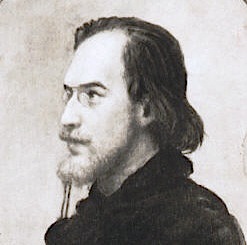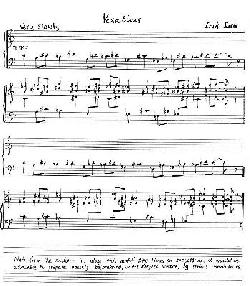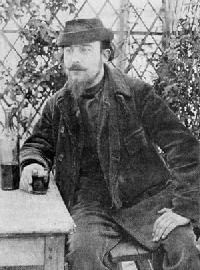Composer (MIDI)
Erik Satie (1866-1925); FRA
 Loading, please wait...
Loading, please wait...
Listening to Satie's dreamy, timelessly beautiful Gymnopedies, one could hardly imagine that their composer was a man more characterized during his lifetime - and after - by his eccentricities than his music. Yet, until recently, more attention has been paid to such items as the 84 identical handkerchiefs and 12 identical velvet costumes found in his wardrobe after his death than to his pioneering art, his influence on Debussy, Ravel, and Cage, or his foreshadowing of the minimalist aesthetic that would emerge close to a century after his birth.
This misplaced emphasis is not difficult to understand, as the complexity of the man and its fascinating manifestations are, initially, more easily understood and immediately entertaining than his compositions. It has been, perhaps, more inviting to visualize the two grand pianos Satie stacked one on top of the other in his Arcueil apartment  (the upper one was used to store correspondence and magazines), than to contemplate listening to a piano piece entitled Genuine Flabby Preludes for a Dog. Or to peruse his exquisite calligraphy of space ships, dirigibles, chateaux, and castles, than to cue up his Sonatina Bureaucratique.
(the upper one was used to store correspondence and magazines), than to contemplate listening to a piano piece entitled Genuine Flabby Preludes for a Dog. Or to peruse his exquisite calligraphy of space ships, dirigibles, chateaux, and castles, than to cue up his Sonatina Bureaucratique.
The shift in focus from the man to his art, and his change in status from musical humorist and dilettante to innovator can be traced to a Satie Festival organized in 1948 by another iconoclast, the American composer, John Cage. He had heard Satie's "Vexations," a three minute piece written on a single sheet with the instructions that it be played 840 times and, in New York in 1963 organized a performance of the piece that involved ten pianists playing in two hour shifts over a period of 18 and a half hours. Not only was Cage deeply affected by the experience, but such diverse artists as Yoko Ono and John Lennon reported that their week-long confinement to bed to protest the Vietnam War was inspired by the Vexations experience.
Since then, Satie's music has become performed more frequently, recorded, and re-considered in the informed light of a half-century. We have come to understand and value more highly his musical output, whose proscribed scope stands in stark contrast to the gigantic proportions of works by his German contemporaries, including Bruckner, Mahler, and Richard Strauss, as he searched for, in his own words, "a music without sauerkraut."
"Without sauerkraut" they may be, but Satie's music is no less pungent. Inspired by sources as diverse as cabaret culture, medieval religion, and Greek antiquity, Satie composed songs, works for piano, and theatrical scores strongly evocative of their origins. Je te Veux (I Desire You) is a product of his quarter-century association with the cabarets of Monmartre; En Habit de Cheval (In Horse-Riding Dress) evokes, despite the work's title, the music and mysticism of the middle ages that so strongly attracted Satie; and the three Gymnopedies,  named for the festival dancing boys at Thyrea described by Herodotus, bespeak the measured grace easily imagined to characterize ancient ceremony and pageant.
named for the festival dancing boys at Thyrea described by Herodotus, bespeak the measured grace easily imagined to characterize ancient ceremony and pageant.
Born in Honfleur (Normandy), Satie moved to Paris in 1884, studied briefly at the Paris Conservatory, and found his first musical voice as the official composer of the Rosicrucian movement; here, he first encountered the Plainsong and Gregorian chants that were to underpin much of his subsequent output. Becoming disenchanted with the Rosecrucians, he found work as a pianist at the famous cabaret, Le Chat Noir, where he met the young Debussy, who, with Ravel, were later to acknowledge their musical debt to Satie and attempt to interest the public in his work.
Financial pressures led Satie to move to a working class suburb, Arcueil, from which he would commute every day by foot to Paris and for rounds of meetings and meals. His twelve mile round trip was punctuated, according to the poet, Apollinaire, with stops at cafes to jot down musical ideas in the little notebooks he took everywhere. He finally scored the success that had long eluded him in Parade, a collaboration with Pablo Picasso, Jean Cocteau, and the director of Les Ballet Russes de Monte Carlo, Serge Diaghilev. The score was so compelling, and the inclusion of guns, car horns, sirens, and typewriters so innovative and raucous as to cause an opening night riot that, thoroughly reported, finally brought Satie to the public's attention, where he remained until his early death at age 59.
Today, Satie's originality and influence are considered equal partners with his actual compositions. If his music does not leave us with spiritual inspiration on the scale of works by Beethoven or Mahler, they draw us into a privileged, often meditative, world with a world view and beauty all of its own.
Biography by David Barg. Copyright © Classical Archives, LLC. All rights reserved.
###
Satie, Erik (Alfred Leslie) [Eric Satie] (b Honfleur, 1866; d Paris, 1925). Fr. composer and pianist, son of Fr. father and Scottish mother. Moved to Paris 1878. Worked as pianist in 1888 at Montmartre cabaret. In same year wrote his Gymnopédies for pf. Met Debussy in 1890. In 1891 joined Catholic Rosicrucian sect and comp. several works for it. Shortly afterwards seemed almost to have retired from comp., writing fewer than 10 works in 12 years. In 1905 entered Schola Cantorum as pupil of d'Indy and Roussel, leaving in 1908. From about 1910 became something of a cult among young composers attracted by the eccentric, humorous titles of some of his works, e.g. Trois Morceaux en forme de poire (Three Pear-shaped Pieces). Strongly influenced group of young composers known as Les Six. Meeting with Cocteau in 1915 led to Diaghilev ballet Parade (1917), in which jazz rhythms are used and the instrumentation incl. typewriter, steamship whistle, and siren. Later, was assoc. with Surrealists and Dadaists. Satie's importance lay in directing a new generation of Fr. composers away from Wagner-influenced impressionism towards a leaner, more epigrammatic style. His harmony is often characterized by unresolved chords, which may have influenced Debussy (or he may have learned the device from Debussy—nobody knows). Melody is simple, sometimes slightly archaic, and scoring economical, with few tutti passages. Socrate is the most ambitious of his works, most of which are comparatively short, the majority being for solo pf. He anticipated many later avant-garde trends; e.g. in Gnossiennes (1890) there are no bar-lines and the score contains verbal instructions bearing little relation to the mus. But beware—behind the clown's mask is a serious composer. Prin. comps.:
STAGE: Le Fils des Étoiles, incidental mus. (1891, prelude re-orch. Ravel 1913); Genéviève de Brabant, marionette opera (1899); Le Piège de Méduse, lyric comedy (1913); Parade, ballet (1917); Mercure, ballet (1924); Relâche, ballet (1924).
ORCH.: En Habit de cheval (1911); Cinq Grimaces (1914); Trois petites pièces montées (1919, also for pf. 4 hands, 1920); La belle excentrique (1920); Jack-in-the Box (1900, unperf. pantomime, orch. Milhaud 1926).
CHORAL: Messe des Pauvres, with organ or pf. (1895, orch. version by D. Diamond 1960); Socrate, 4 sop.. small orch. (1918).
VOICE & PIANO: 3 Mélodies de 1886; 3 Poèmes d'Amour (1914); 3 Mélodies (1916); Ludions (5 songs) (1923).
VIOLIN & PIANO: Choses vues à droit et à gauche (sans lunettes) (1914).
PIANO: 3 Sarabandes (1887-8, orch. Caby); 3 Gymnopédies (1888, Nos. 1 and 3 orch. Debussy 1896, No.2 orch. H. Murrill and by Roland-Manuel); 3 Gnossiennes (1890, orch. Lanchbery; No.3 orch. Poulenc 1939); Trois Préludes from Le Fils des Étoiles (1891, orch. Roland-Manuel); Valse, Je te veux (c.1900, arr. for v. and orch., also arr. for orch. by C. Lambert); 9 Danses gothiques (1893); 4 Préludes (1893, Nos. 1 and 3 orch. Poulenc, 1939); Prélude de la porte héroïque du Ciel (1894, orch. Roland-Manuel 1912); 2 Pièces froides (1897); 3 Nouvelles pièces froides (pre-1910); Le Poisson rêveur (1901; version for pf. and orch. by Caby); 3 Morceaux en forme de poire, for 4 hands (1903; orch. Désormière); 12 Petits Chorals (c.1906); Passacaille (1906); Prélude en tapisserie (1906); Aperçus désagréables, 4 hands (1908-12); 2 Rêveries nocturnes (1910-11); En Habit de cheval, vers. for 4 hands (1911); 3 Véritables Préludes flasques (pour un chien) (1912); 3 Descriptions automatiques (1913); 3 Embryons desséchés (1913); 3 Croquis et agaceries d'un gros bonhomme en bois (1913); 3 Chapitres tournés en tous sens (1913); 3 Vieux Séquins et vieilles cuirasses (1913); Enfantines (9 pieces) (1913); 6 Pièces de la période 1906-13; 21 Sports et divertissements (1914); Heures séculaires et instantanées (1914); 3 Valses du précieux degoûté (1914; orch. Greenbaum); Avant-dernières pensées (1915); Parade, suite for 4 hands from ballet (1917); Sonatine bureaucratique (1917); 5 Nocturnes (1919); Premier Menuet (1920).
Copyright © 1996 Oxford University Press - By permission of Oxford University Press
###
Read biography at allmusic.com.

|
Listening to Satie's dreamy, timelessly beautiful Gymnopedies, one could hardly imagine that their composer was a man more characterized during... More
|
-
Stage Works
1 midi
-
Keyboard Works(includes 3 Gymnopédies)
53 midis
- Gnossiennes and Gymnopédies
28 midis
- 6 Gnossiennes
14 midis
- 3 Gymnopédies
14 midis
- 6 Gnossiennes
-
Preludes
2 midis
-
Works for Piano Duo or Piano 4-Hands
4 midis
-
Other Keyboard Works
19 midis
- Embryons desséchés (Dried-up Embryos)
3 midis
- Fantaisie-Valse
1 midi
- Le Piccadilly, march
1 midi
- 4 Ogives
4 midis
- Poudre d'or, for piano
1 midi
- 3 Sarabandes
6 midis
- Sonatine bureaucratique
1 midi
- Valse-Ballet, for piano
1 midi
- Vexations
1 midi
- Embryons desséchés (Dried-up Embryos)
- Gnossiennes and Gymnopédies
-
Orchestral Works
5 midis
-
Vocal Works
5 midis
- Works for Solo Voice
5 midis
- Works for Solo Voice
-
Stage Works
1 midi
-
Keyboard Works(includes 3 Gymnopédies)
53 midis
- Gnossiennes and Gymnopédies
28 midis
- 6 Gnossiennes
14 midis
- 3 Gymnopédies
14 midis
- 6 Gnossiennes
-
Preludes
2 midis
-
Works for Piano Duo or Piano 4-Hands
4 midis
-
Other Keyboard Works
19 midis
- Embryons desséchés (Dried-up Embryos)
3 midis
- Fantaisie-Valse
1 midi
- Le Piccadilly, march
1 midi
- 4 Ogives
4 midis
- Poudre d'or, for piano
1 midi
- 3 Sarabandes
6 midis
- Sonatine bureaucratique
1 midi
- Valse-Ballet, for piano
1 midi
- Vexations
1 midi
- Embryons desséchés (Dried-up Embryos)
- Gnossiennes and Gymnopédies
-
Orchestral Works
5 midis
-
Vocal Works
5 midis
- Works for Solo Voice
5 midis
- Works for Solo Voice









 Files of this type are not available at this time. Please select ALL from above.
Files of this type are not available at this time. Please select ALL from above.
 Click on a category to view the list of works
Click on a category to view the list of works


